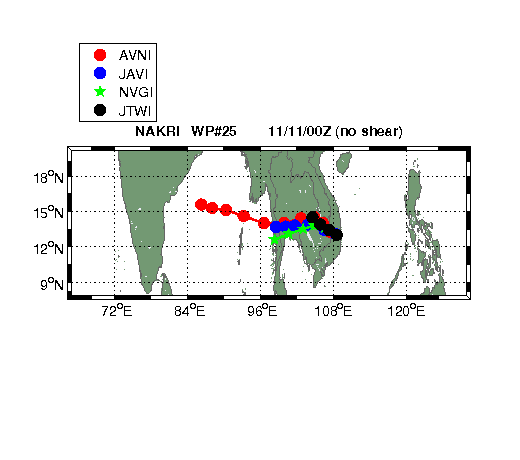Tropical Cyclone Track and Intensity Forecasts and Guidance
Disclaimer: The tropical cyclone objective aids
displayed on this web site are collected from multiple forecast centers and may
or may not be the most
current data available to the operational forecast centers. The MIT tropical
meteorology group obtains these forecasts for research purposes and assumes
no responsibility for their use in the forecasting of tropical cyclones.
Concerned individuals or organizations should confirm these forecasts with
official
sources.


The NCEP track ensembles for each storm may be found at http://wwwt.emc.ncep.noaa.gov/gmb/pan/track_ens.html
CHIPS forecasts in ATCF format may be downloaded from ftp://texmex.mit.edu/pub/emanuel/JTWC/
Legend
Note: Last letter I in acronym denotes interpolation from previous forecast
CPHC: Central Pacific Hurricane Center
JTWC: Joint Typhoon Warning Center
NHC: National Hurricane Center
----------------------------------------
AEMN: NCEP GFS ensemble mean
AFW1: MM5 AVN
AVNO: NCEP GFS run
A90E: NHC 90 Early (Statistical-dynamical model)
A98E: NHC 98 Early (Statistical-dynamical model)
BAMD: Beta and Advection Model (Deep layer version)
CHIPS: Coupled Hurricane Intensity Prediction System
CHIPS Ens.: CHIPS ensembles. These are constructed by varying the initial intensity, initial rate of intensification, and shear. Shear is derived from NCEP GFS forecasts.
COAL: NRL COAMPS
EGRR: United Kingdom Meteorological Office
GFDL: Geophysical Fluid Dynamics Laboratory hurricane model
GFDN: FNMOC version of GFDL
GFDT: SAFA translated version of GFDN (SAFA=Systematic Approach to Tropical Cyclone Forecasting Aid)
HWRF: Hurricane Weather Research and Forecast System
JTYM: Japan Meteorological Agency Typhoon Model
JAVN: GFS positions from WXMAP
LBAR: DeMaria barotropic model
NGPS: NOGAPS
NGPT: SAFA translated version of NOGAPS
SHIPS: Statistical Hurricane Intensity Prediction System
STIPS: Statistical Typhoon Intensity Prediction System (Pacific version of SHIPS)
UKMO: United Kingdom Meteorological Office